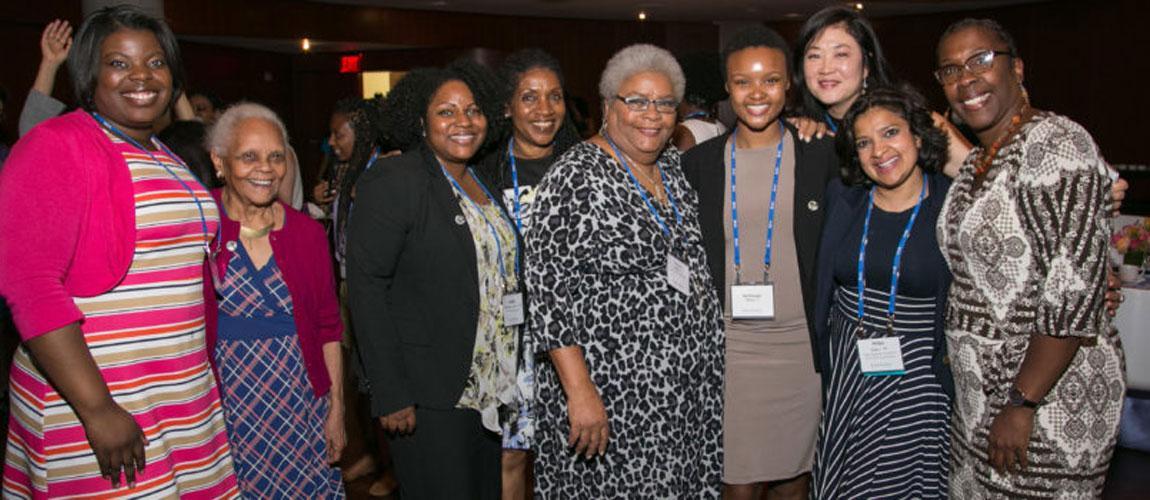I attended my recent Barnard College reunion with a group of fabulous women: architects, entrepreneurs, professors, chemists, dancers, doctors, recovering retirees, and brave nonprofit leaders who renewed my faith in women’s power to make the world a better place. I also had the honor of participating in a panel discussion entitled, “Still We Rise: A Panel of Barnard Alumnae Activists,” where I experienced the amazing ability of authentic conversation to bring understanding and deep connection. It is this type of genuine exchange that will allow women to come together across our differences and solve society’s most difficult problems.
The panel was a diverse group, all Barnard alums, doing amazing work in the areas of racial equity, housing and education reform, gender violence and LGBT rights. The skillful moderator, a CNN national correspondent and alum, Deborah Feyerick, inquired about our backgrounds, school experiences, and the issues of bias, sexism, racism, classism that informed our work.
During the conversation, I mentioned the Alumnae of Color Dinner I attended the first night of the reunion and how exciting it was for me to see so many vibrant and confident women of color at Barnard; there had been so few in my class year and we knew little of the women who had come before us. I hadn’t expected it, but I got emotional describing the dinner and explaining how my time at Barnard really incited my activism, my decision to go to Harvard Law School and my work as a diversity and inclusion specialist in the C-suites of corporate America and the communities in my hometown of Baltimore.
Then quite unexpectedly, Deborah decided to get real. She turned to me and with great skill and a blameless curiosity posed the question that so many well-meaning white folks rarely feel safe asking a black woman, “Why an ALUMNAE OF COLOR Dinner?” And then she added, “Do these type of events further separate the minority group from the larger population and exclude others? Why separate spaces? Wouldn’t it be better if we had events that brought everyone together from different groups, but with like minds, so that they can bridge the gaps and solve issues collectively?” These were questions I had heard many times before, but mostly as accusations. They were the same critical and disapproving inquiries made of the Black Harvard graduates this year when they, in addition to the traditional ceremony, created their own graduation event. Usually what follows these questions, is defensive, guarded and blaming talk by both sides or a silencing pretense so that we can “all get along.”
But something quite different happened during this Saturday morning at my alma mater. Surrounded by an audience of bright and caring women, a group of truth-telling and passionate panelists led by an open-hearted, inquisitive moderator, these questions found a safe place to be explored. I thought for several moments and then responded with as much truth and compassion as I could, hoping to match the courage and spirit of the inquiries elicited.
So, I answered first in the affirmative, “Absolutely, yes, of course, we need spaces where we can all come together.” But then I began to explain that in order to bridge the gaps, build inclusive institutions and solve the problems we confront in this world, we need lots of spaces. However, the import of assembling diverse groups of like-minded people does not negate the need for people who are severely underrepresented and historically excluded in a college, an organization, or a society to come together on their own for their own.
I used my own experience to describe to the audience how imperative it is for women of color to find some solace and direction to navigate success in a majority white institution. It was at Barnard I first felt the sting of racism and the impact of my race on my daily life. Before I came to college, I didn’t even know I was Black. I mean, I knew, but I didn’t know my racial identity was relevant. I thought racism, personal and institutional, was over. However, it was also at Barnard that I discovered a broader and deeper narrative of African-Americans- one that not only included the struggles of black folks across the globe, but their extraordinary brilliance, resilience and achievements despite those struggles. This new information came to me by being in spaces with other black people who affirmed this new, exciting but disorienting reality. The black, upper class women and men inspired me and encouraged me to use the resources of the institution to aspire to more.
I also asked the women in the room to imagine how difficult it is for women of color to get to know each other in a majority organization without intentionally creating settings where we can all gather. It is so hard to appreciate if you are in the majority. I jokingly told the true story of one of my “besties” from college, a black woman from Denver. As freshmen, we would see each other every few weeks in the hustle and bustle of changing class periods. We would wave frantically, but we couldn’t seem to reach each other. We were in the current of bodies flowing in different directions and anxious to get to class on time, we didn’t have time to stop, chat and exchange phone numbers. We ultimately found each other and are the dearest of friends till this day. Less than 25 black women graduated with us in a class of over 500 and many of them were commuters which meant they lived off campus, further limiting their visibility to us.
Being in the minority around some salient aspect of your identity also exacerbates your loneliness, and isolation. When you couple that with the dominance and power of white, elite, and western norms that shape every aspect of the institution and larger society – what and who is valued, what is expected, how one dresses, speaks and how one shows intelligence and confidence- minorities experience an exhaustion and invisibility that the majority rarely experiences. So, when students of color within a majority environment get together around their affinity, they are truly finding community – they are discovering a place to rest, restore, support and celebrate not only themselves, but their worth and their culture. It is in this community, they are also able to do some reality testing and problem solving with others like them in the face of the subtle and unconscious biases they face daily — white teachers and classmates expecting too little, expecting too much, or constantly testing them against negative stereotypes.
When we see women from diverse backgrounds or other groups of underrepresented people coming together, this is cause for celebration. They are getting what they need to not only survive but thrive. We don’t need to see it as a rejection or an unwillingness to assimilate. We need to understand the difficult truth; many of my experiences as a black women years ago at Barnard are the reality for many women of color still. Many majority institutions have been trying with some success, but they are still not multicultural and inclusive of all. I was happy to hear during our reunion that this year Barnard announced a diversity initiative to address these issues more holistically and strategically. Groups deriving strength from affinity-based associations may not be the type of assimilation some people expect or feel comfortable with initially, but it is a form of adaptation to a majority environment that allows minorities to stand strong and bring their best to that environment. When institutions and individuals are perceptive, they actually support these efforts because they recognize how different groups provide new perspectives, talents and networks that ultimately benefit the entire institution. In other words, mutual adaption is the new assimilation.
As a single-sex school Barnard itself is the ultimate embodiment of the benefit of affinity group efforts. Barnard has not accepted men because it believes there is still a space needed where women can come together, discover and be strengthened by the untold stories of women’s achievements as well as develop the confidence and capabilities to go out in the world and make a difference. These women know the world is full of men, but it is truly a gift to have a place where women are supported to find their best selves and defy the limitations that male norms and patriarchy dictate.
Why an Alumnae of Color Dinner? Sometimes, that question is really a genuine curiosity about what happens at these events and a sadness that we don’t all get to be a part of something so awesome. Even though this dinner was opened to anyone – and a few white people attended, including the interim President of the college, Robert Goldberg – most alumnae were not aware it was open. The Dinner’s theme, “Hard Times Require Furious Dancing,” a quote from Alice Walker, was a statement from these young, sassy and confident women that they were coming together to be real – to speak to the hard times as well as the dancing – and to do it with pride, steeped in the strength of their culture. Beautiful women stood at the podium quoting poet and black alumna, June Jordan, and performing a heartfelt tribute to alumna, Judge Sheila Abdus-Salaam, the first African-American women on the New York Court of Appeals who had recently passed. At our tables, we were instructed to share with each other, “A time love changed your life” and we happily laid our souls bare. Towards the end, we watched the wealth of our networks combine in an exercise that called on us to connect around “what we had to give” and “what we needed.” It was community at its best; it was nourishing and uplifting and it ended with a woman of color DJ spinning music that got us all up on our feet and on the dance floor.
I didn’t realize the impact of the dinner on me and the power of the space our panel discussion created until the weekend was coming to a close. So many women of every background and age came to me throughout the rest of the reunion to tell me how much they learned and how much they appreciated my comments and the way I answered Deborah’s questions. Conversations about race, don’t always end up with the positive outcome ours did. What I know now is that on that Saturday morning, Deborah dared to bring us into an authentic conversation in a mixed group and we discovered that we can ask each other almost any question if we are genuinely interested in the answer, come open-hearted and without blame, shame or attack. It may not always be perfect and the truth can sometimes be hard to digest.
But, as I often say, “Conversation is a contact sport.”™ We have the possibility of true connection and relationships when we are not tip-toeing around each other or trying to ignore our differences. We have to be willing to notice, respect, and support the differences between us. Women of color undoubtedly need their spaces to fortify and celebrate. White women also need their spaces to understand what it means to be white in this society and how to use their privilege to break down racial and ethnic bias and exclusion. When we give each other these spaces, we do not solidify divisions. Rather, we give ourselves the best chance for powerful and productive work when we do come together on behalf of a common goal. So yes, there is so much hope and pride in both our separate and our combined spaces. But it is up to each of us to bring the curiosity, courage, and compassion to each of these spaces. This is how we will change the world for the better.
Verna Myers,
A Proud Black Alumna of Barnard College ‘82


